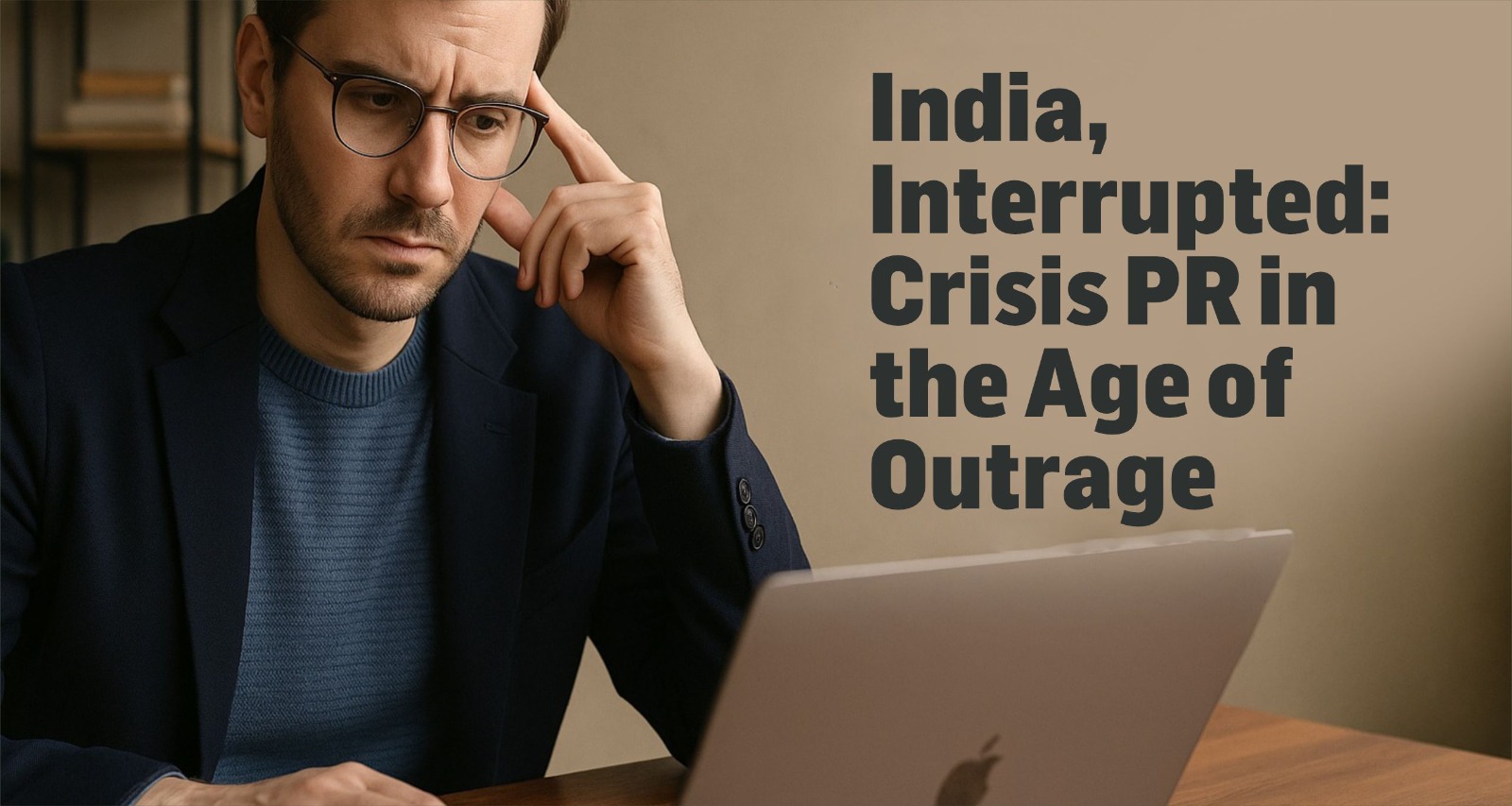
India, Interrupted: Crisis PR in the Age of Outrage
Have you ever paused to wonder why a simple comment or event sometimes spirals into a nationwide storm overnight? Why does public outrage grow so fast in India’s digital world that even well-meaning brands or leaders find themselves caught in a raging fire? In today’s India, where news travels faster than ever, the traditional rules of public relations no longer suffice. The age of outrage demands a new kind of crisis PR — one that is fast, transparent, and deeply rooted in understanding Indian society’s complexities. So, how do organisations survive this digital whirlwind? How can they restore trust when trust feels so fragile? This blog digs deep to unpack these questions from the roots.
The Roots of Outrage: Understanding India’s Digital Pulse
India’s massive internet growth, propelled by affordable smartphones and data, has created a hyper-connected society. With over 800 million internet users, social media platforms such as X (formerly Twitter), Facebook, and Instagram have become spaces where public opinion is formed and exploded. However, this rapid digital spread also comes with a price: misinformation and outrage thrive. A recent example is the misinformation around India-Pakistan tensions that almost escalated into conflict in May 2025, largely fueled by unverified social media posts.
Source:
https://www.theguardian.com/media/2025/may/28/how-social-media-lies-fuelled-a-rush-to-war-between-india-and-pakistan
This digital outrage is not just random; it taps into India’s deep socio-political, religious, and cultural sensitivities. Thus, crisis PR in India must appreciate this context — the layers of identity, history, and sentiment that turn a minor incident into a national controversy.
Crisis PR Challenges Unique to India
Speed vs Accuracy: The public expects instant responses. Delays lead to rumours filling the vacuum, but quick replies risk inaccuracies that fuel further backlash.
Cultural Diversity: India’s diversity means messages can be interpreted differently across regions, languages, and communities.
Political Polarisation: Public opinion is often influenced by political agendas, complicating PR efforts.
Digital Misinformation: AI-generated fake news and doctored videos have become common, requiring vigilant monitoring and fact-checking.
Key Lessons from Recent Indian Crisis Cases
Ranveer Allahbadia’s Social Media Storm: A popular influencer’s offhand remark spiralled into police investigations and public outrage. The incident underlined how influencers must balance freedom of expression with cultural sensitivity and timely, empathetic crisis responses. https://apnews.com/article/india-youtuber-controversy-freedom-speech-305bb55cdd87e6003791424e8ff78859.
Panchkula’s Blackout Blunder: An administrative failure to communicate about a cancelled blackout during a mock drill led to public confusion and anger. The lack of proactive communication demonstrated the danger of silence and highlighted the importance of maintaining active and transparent communication channels during crises. https://timesofindia.indiatimes.com/city/chandigarh/panchkula-admin-does-it-again-fails-to-communicate-mock-drill-cancellation/articleshow/121503809.cms
Akola Police Accountability: Viral video evidence of police misconduct led to swift action and public trust restoration. This demonstrated that accountability and visible corrective steps are vital in Indian crisis communication. https://timesofindia.indiatimes.com/city/nagpur/akola-cop-abuses-government-doctor-suspended-after-video-goes-viral/articleshow/121448748.cms.
Strategies for Crisis PR in the Age of Outrage in India
Empathy Above All: Indians respond to emotional authenticity. Acknowledging hurt and showing empathy can de-escalate anger.
Real-Time Monitoring: Use AI and analytics to monitor social sentiment and detect potential issues before they blow up.
Transparent Communication: Openly share facts, admit mistakes, and outline corrective steps clearly.
Community Engagement: Dialogue with affected communities and stakeholders to rebuild trust.
Culturally Sensitive Messaging: Tailor communication to respect regional and cultural nuances.
Video Insight 1: Real Voices from India’s PR Landscape
An insightful discussion that perfectly supports the Indian context of crisis PR comes from the afaqs! Communication session on crisis management. It highlights the urgency of real-time communication, human empathy, and cultural understanding in PR responses today.
In this video, PR experts dissect actual Indian crisis cases and explain how brands should respond when faced with digital backlash. It’s an essential learning resource for anyone serious about mastering PR in modern India.
Video Insight 2: Global Framework, Indian Fit
For a broader global context with sharp relevance to India’s evolving landscape, another valuable video outlines how brands must navigate viral crises across platforms — especially in a culturally and politically charged environment like ours.
This episode from a crisis communication podcast examines how viral outrage demands more than damage control — it calls for vulnerability, active listening, and strategic storytelling, especially when operating in a volatile space like Indian digital media.
Why Traditional PR No Longer Works
India’s digital and social media evolution means that simply putting out official statements or press releases won’t cut it anymore. Outrage is viral; a single misstep can lead to calls for boycotts or legal action. Instead, crisis PR needs to be agile, conversational, and rooted in Indian values of respect and collective responsibility.
Conclusion
In this age of outrage, how prepared is your brand or organisation to face the unexpected? Is your crisis PR strategy ready for India’s complex social fabric and lightning-fast digital backlash? More importantly, do you see crisis management as an opportunity to demonstrate authenticity and rebuild trust rather than merely damage control?
India’s digital age is not just about interruption but transformation. Brands that humanise their responses, listen sincerely, and act swiftly will not only survive crises but emerge stronger. Because in the end, crisis PR in India isn’t just about protecting a name — it’s about protecting the connection between brand and people, in the age of outrage.




